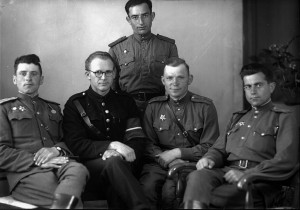 8 May 1945 - 16 April 1946. As the rest of Denmark celebrated its liberation on the 4th and 5th of May in 1945, Rønne and Nexø were bombed by Soviet planes.
8 May 1945 - 16 April 1946. As the rest of Denmark celebrated its liberation on the 4th and 5th of May in 1945, Rønne and Nexø were bombed by Soviet planes.For two days - the 7th and 8th of May - bombs rained down on the two towns, destroying many of the old buildings in the centre.
The first Red Army soldiers went ashore at Rønne Harbour on the 8th-9th of May 1945. Some of the them were sent by train to Sandvig, where they were met by the local resistance and curious locals.
They were frontline soldiers who had quickly been redeployed from the German front.
They then marched on to Allinge, where they were once more met by members of the resistance in front of the butcher’s yard (now a supermarket).
Many thousands of Red Army soldiers were stationed on Bornholm for nearly a year.
A large number of them were quartered in the northern part of the island, living in hotels, hostels, guest houses or tents in nature.
 In the forests by Hammersholm, there is even a grassy field called Russersletten - The Russian Plain - and some of their trenches can still be found on the slopes leading down to Lake Hammer and on the Hammerknuden promontory.
In the forests by Hammersholm, there is even a grassy field called Russersletten - The Russian Plain - and some of their trenches can still be found on the slopes leading down to Lake Hammer and on the Hammerknuden promontory.They set up stables for the horses in the moats by Hammershus, and the horses were shoed at the hostel in Sjøljan. The Soviets left the island on the 16th of April 1946.
The 30 who died during their deployment on Bornholm were buried in Allinge, where they established a special cemetery in the western end.
It’s called the Russian Cemetery.
There are also 55 German refugees and soldiers buried in the cemetery’s eastern end.
 4 Russian officers and Axel Gornitzka, photo by Kjøller
4 Russian officers and Axel Gornitzka, photo by KjøllerDuring the development of the V1 and V2 flying bombs in Peenemünde, Bornholm served as an observation island, as all the test launches were closely monitored.
When one of the V1 bombs landed on Bornholm, two police officers sketched and photographed it, which would be prove to be immensely useful to British decision-makers.
As the Allied bombing campaign intensified, Bornholm became a surveillance outpost with radar stations that could transmit bomber alerts to Berlin.
At the end of the war, Bornholm was a destination for many refugees from eastern Germany and areas in Lithuania.
During the development of the V1 and V2 flying bombs in Peenemünde, Bornholm served as an observation island, as all the test launches were closely monitored.
As the Allied bombing campaign intensified, Bornholm became a surveillance outpost with radar stations that could transmit bomber alerts to Berlin.
At the end of the war, Bornholm was a destination for many refugees from eastern Germany and areas in Lithuania.
Peace finally came on the 4th of May all over Denmark - or so we thought!
 This photo shows the newly arrived Germans at Solomon’s Chapel at the Hammeren promontory.
This photo shows the newly arrived Germans at Solomon’s Chapel at the Hammeren promontory.On the 7th of May, however, Nexø and Rønne were bombed by Soviet planes.
Several people were killed, and as we received warnings that more bombers were on their way, the two towns were evacuated.
The Soviet airforce returned on the 8th of May, dropping many more bombs and causing massive devastation and fires in both towns.
In the days that followed, the islanders felt a great deal of resentment towards the rest of Denmark, as they felt they had been abandoned.

The radio made no mention of the bombings; all we heard about was the celebrations going on in Copenhagen, and it took many days before it was reported on.
On the 8th of May, the first Soviet high-speed vessels arrived in Rønne.
They were soon followed by large Soviet forces - so many, in fact, that we feared what was about to come.
However, the Soviets very quickly relocated the approximately 25,000 soldiers and refugees who were on the island.
The Soviets themselves only departed from Bornholm on the 5th of April 1946 after the first Danish soldiers arrived on the island.
Bornholm was finally free!




